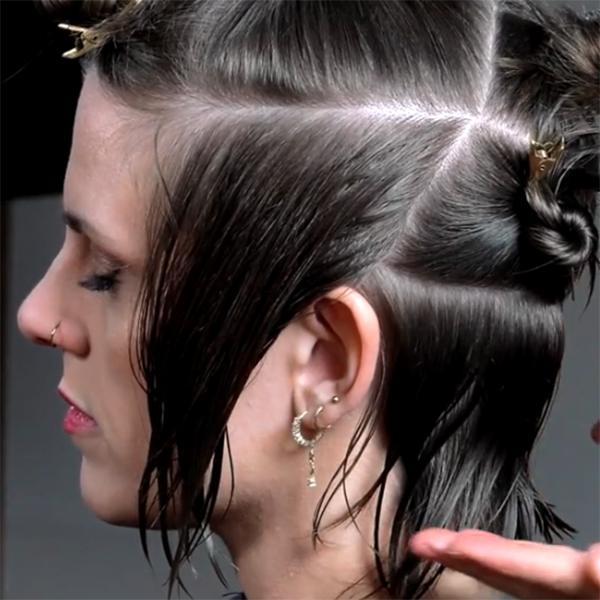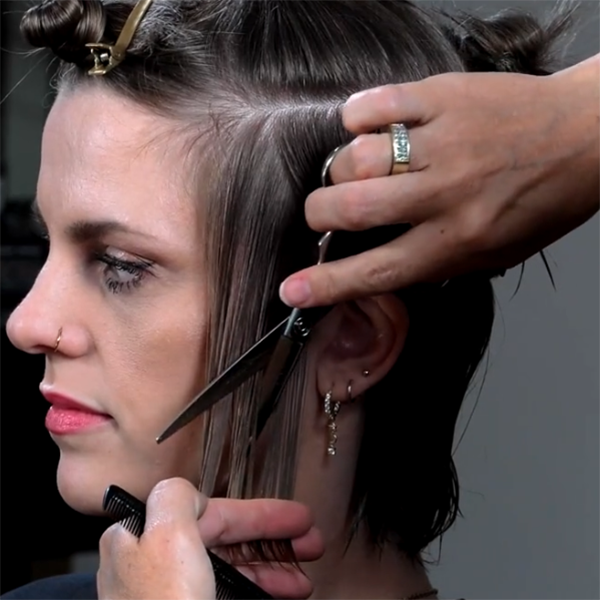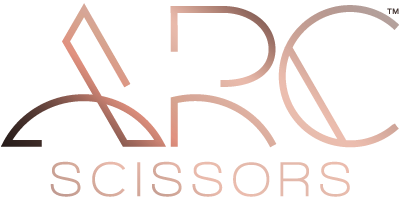The Bixie: 5 Cutting Techniques to Master the Look

Photo Credit: @brianacisneros
The bixie made its comeback in 2022—and it’s not slowing down. This soft-meets-edgy pixie-bob hybrid flatters nearly every texture, and ARC™ Scissors Ambassador Briana Cisneros (@brianacisneros) is sharing her go-to techniques for creating the look with control, precision, and movement.
Start by Sectioning for TWO Haircuts
Because the bixie blends the discipline of a bob with the freedom of a pixie, Briana divides the head into two technical zones using the parietal ridge as her visual landmark.
-
Above the parietal ridge: Keep dry. This top section will control movement, texture, and volume.
-
Below the parietal ridge: Keep wet. This area establishes the strong, clean foundation of the haircut.
Then, she creates a triangle section above each ear, using the recession point as the top corner. These triangles form the undercut panels—the core of the bixie’s shape.
Pro Tip: Adjust triangle size to density. Thicker hair needs a larger section for balance; finer hair needs a smaller section for control. Keeping extra length on top ensures the “bob” finish while allowing the sides to collapse elegantly.

2. ARC Paragon & Razor
The bixie demands agility. You’re cutting two shapes—pixie and bob—so you need a tool that transitions between both effortlessly.
Briana only uses two tools for the entire cut:
-
A straight-edge razor
Why the Paragon II?
Because it’s the best scissor in the world built for both wet and dry cutting. The precision-forged Japanese steel and extended blade length allow for clean, controlled slides, slicing, and soft shaping—all without compromising the hair’s integrity. The convex edge glides through hair without “pushing” or “pulling” giving Briana complete freedom to move between foundational wet cutting and detailed dry refinement.
Technical Breakdown:
- The long 6.5" blade maintains tension across wide subsections, crucial when building internal structure through the nape and occipital.
- The ergonomic offset handle keeps wrist alignment neutral, allowing long cutting strokes close to the neck—ideal for creating that tight, balanced silhouette underneath.
- The convex edge geometry prevents fraying during slide or slicing motions—essential when flicking out perimeter ends for that signature bixie texture.
3. Create a Foundation with Slide Cutting
“Most bobs we talk about are graduated or square, and they entail a lot of buildup of weight,” explains Briana. “With the bixie, there’s an intense amount of weight removal.”
Briana begins by using slide cutting to carve her foundation with the Paragon II:
-
Enter the section with blades slightly open.
-
Glide through mid-shaft to ends, closing the shear as you exit in one continuous motion.
-
Maintain a low elevation (0°–30°) to preserve length while tapering density.
This creates wispy, piecey ends and that signature “flicked out” movement the bixie is known for—without leaving harsh lines.
Pro Tip: Adjust pressure based on texture. For fine hair, keep tension light and glide slower. For coarse hair, increase tension and speed to release more weight.

4. Debulk with a Razor (or Your Scissor!) to Avoid a “Saggy” Undercut
The nape holds the most weight, and if not handled precisely, can make the shape look heavy—or “saggy.” Briana removes excess bulk here using her razor, but if you don’t have one, the Paragon II can achieve a similar effect.
Technique:
-
Take a center part and two diagonal-forward subsections near the hairline.
-
Hold the hair straight out from the head at 45°.
-
Using the edge of your Paragon II, open and close the blades rapidly in a rhythmic motion to “shatter” the weight, keeping length at the ends.
This scissor motion mimics a razor’s slice but with more control, reducing the risk of over-thinning and maintaining the sleek nape contour.
Pro Tip: When slide-cutting the nape, always angle your scissor parallel to hair growth—this ensures the ends flick out naturally rather than collapse inward.

5. Connect the Crown to the Undercut with a Traveling Guide
The blend lives at the crown—where bob structure meets pixie freedom.
Briana switches back to her Paragon II, takes a center vertical section, and elevates it straight up (90°). Using a fast, shallow up-and-down motion, she removes just the corner of the weight to create diffused texture.
“It doesn’t create a full layer,” Briana explains. “It’s just a little pop of texture—enough to make it move.”
She then uses that section as a traveling guide, working around the head to connect the top and undercut. The result? Soft internal lift and feathered movement that lets the bixie fall perfectly between structured and undone.
Pro Tip: Dry cut the top later with the tips of your Paragon II to visually balance length and add micro-texture to the surface. The fine tip and precision edge make it easy to refine the crown without disturbing your perimeter.






Comments on this post (0)